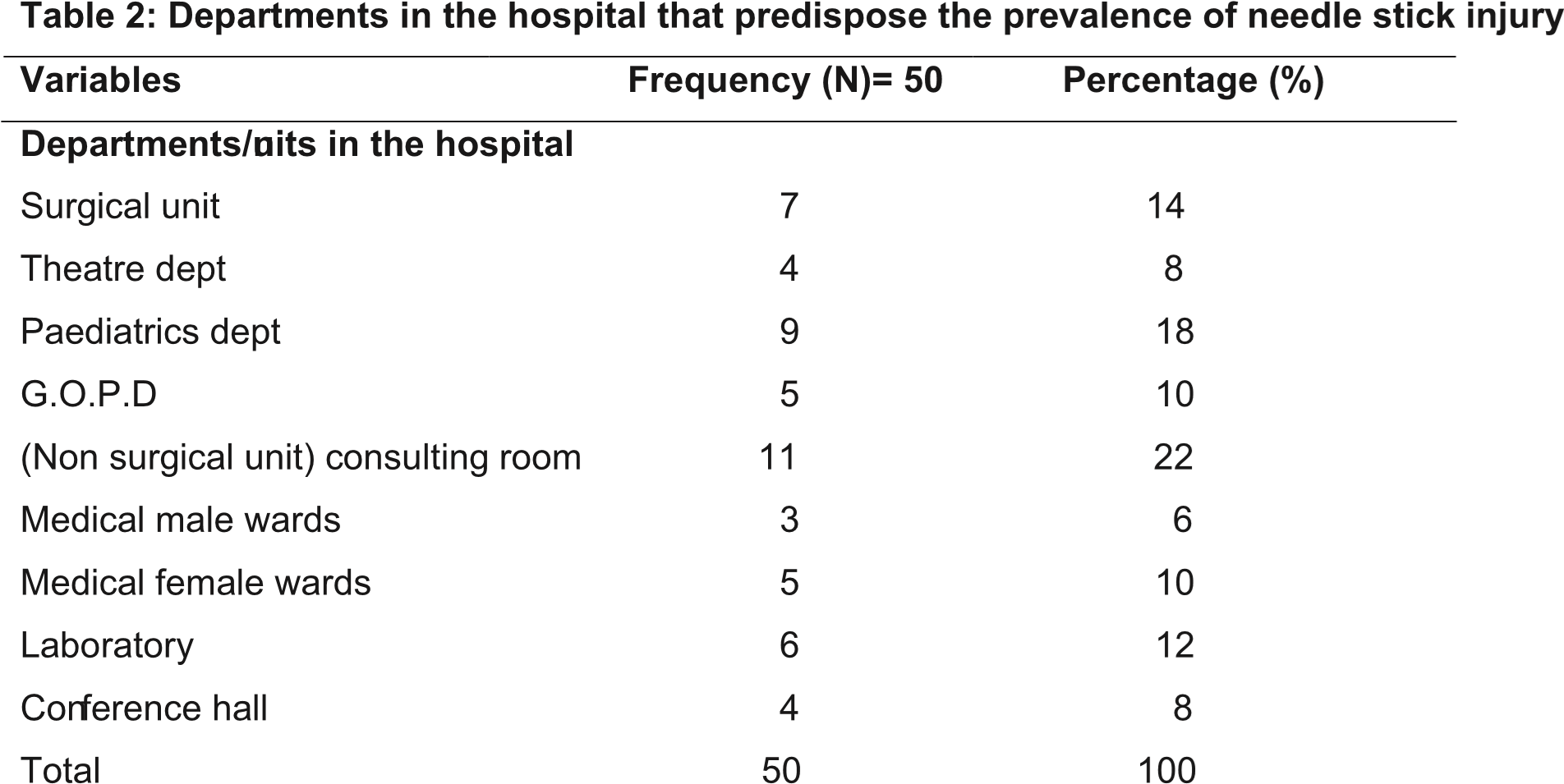Prevalence of needle stick injuries among healthcare workers at the Federal Medical Centre, Owerri, South-East Nigeria
Keywords:
Needle- stick injury, hepatitis, healthcare workers, occupational hazard, disposal containersAbstract
Background: A needle-stick is a sharp-pointed instrument used for puncturing tissues or passing a ligature around or through a vessel, but possibly also it could be a sharp instruments or objects for other purposes. Healthcare workers (HCW) can easily contact infections with blood-borne pathogens such infections are hepatitis B virus (HBV), hepatitis C virus (HCV) and human immunodeficiency virus (HIV), when health workers are exposed to occupational blood diseases through the use of sharp instruments and needle sticks.
Objective: This research investigated the prevalence, causes and prevention of needle stick injury among healthcare workers at the Federal Medical Centre (FMC), Owerri.
Materials and Methods: The sample size was fifty respondents while the major instrument for data collection was a well constructed, validated and reliable tested questionnaire, including observations made. Data obtained was analysed using frequency distribution, and chi-square.
Results: Results of the a study indicated majority of the injuries occur during injection procedure (34%), recapping (14%), and improper disposal of used syringes and needle (6%), stress had (6%), overfilled disposal boxes also recorded (2%) and lack of experience among workers had (0%). Sex of respondents recorded 86% for female and 14% for male.
Conclusion: A standard and understandable programmes to avert NSI should be encouraged.. Examples of such measures are as follows: recapping should be avoided, the use of disposal containers should be encouraged, surgical gloves and other safety devices can also be used to reduce a high cause of developing chronic blood-diseases like hepatitis, cirrhosis and liver cancer.
References
United States (US) Department of Labor, Occupational Safety and Health Administration Compliance
Directive”.CPL, 2001; 2-2, 69.
R e t r i e v e d f r o m http://www.google.com, Date: 20/06/2013.
Perry, J., Parker, G., & Jagger, J. Percutaneous injury; Advances in Exposure Prevention; 2003;7:42-45
Centers for Disease Control and Prevention (CDC). National Institute for Occupational Safety and Health (NIOSH) Publications: Preventing Needle- stick Injuries in Health Care Settings, 1999. Retrieved from http://www.google.com. Date: 20/06/2013.
“American Nurses Association: Needle stick injury prevention guide. USA. West Washington, D.C; 2002.
R e t r i e v e d f r o m
http://www.NursingWorld.org Date; 20/01/2014.
Annette, P.U., Elisabetta, R., & Yvan, H. Determination of the worldwide burden of disease attributable to contaminated sharps injuries among healthcare workers: WHO, P r o t e c t i o n o f t h e H u m a n Environment (PHE), Geneva,
Switzerland; 2005.
Jagger, J & Bentley, M.B. Injuries from vascular access safety devices: High risk factors and preventable. Collaborative EPIN Monitoring and Surveillance Group. Journal of Intravenous Nursing, 1997; 20: 33–39.
Lamontagne, F., Abiteboul, D.,
Lolom, I, et al., “The performance of safety-engineered devices in preventing needle stick injuries in 32 French hospitals”. Infection Control
Hospital Epidemiology, 2007; 28:1823.
Lekhraj R., Rosidah Z., Azhar M & Leong W. “Needle Stick Injuries and Factors Associated Among Health
Care Workers” in a Malaysian
Hospital: Europea Journal of Social Sciences; 2010; 13 (3): 10-20.
L e e , L . K . & H a s s i m , N .
“Consequences of the prevalence of needle stick injuries in a general hospital in Malaysia and its risk factors in clinical practice”.
Environment Health and Preventive Medicine, 2005; 10: 31-41.
Maqbool, A. Assessment of knowledge, attitude and practice (KAP) among healthcare workers on needle stick injuries. Annals of Saudi Medicine, 2002; 22 (5-6): 1-4.
Gurubacharya, D.L., Mathura, K.C. & Karki, D.B., Knowledge, Attitude and Practice (KAP) among
Healthcare Workers on Needle Stick Injuries”. Kathmandu University Medical Journal, 2003;1(2): 91-94.
Hofranipour, F.G., Asadpour, M.,
Ardebili, H.E., Niknami, S & Hajizadeh, E., “Needle stick/sharp injuries and determinants in nursing care. European Journal of Social Sciences”, 2009. 2(2):191-197.
Retrieved from www.google.com, Date1: 22/04/2013
Pugliese G, Bartley J, McCormick R. Selecting needle-stick injury prevention products. In: Medical device manufacturing and technology, E Cooper (ed.). London: World Markets Research Centre, 2000, pp. 57-64
Puro V, Petrosillo N, Ippolito G. “Risk factors of hepatitis C seroconversion after occupational exposure in health care workers”. Am Journal Infect Control (AJIC)
; 23:273-7

Downloads
Published
How to Cite
Issue
Section
License
Copyright (c) 2023 Research Journal of Health Sciences

This work is licensed under a Creative Commons Attribution-NonCommercial-NoDerivatives 4.0 International License.
Research Journal of Health Sciences journal is a peer reviewed, Open Access journal. The Journal subscribed to terms and conditions of Open Access publication. Articles are distributed under the terms of Creative Commons License (CC BY-NC-ND 4.0). (http://creativecommons.org/licences/by-nc-nd/4.0). All articles are made freely accessible for everyone to read, download, copy and distribute as long as appropriate credit is given and the new creations are licensed under the identical terms.

